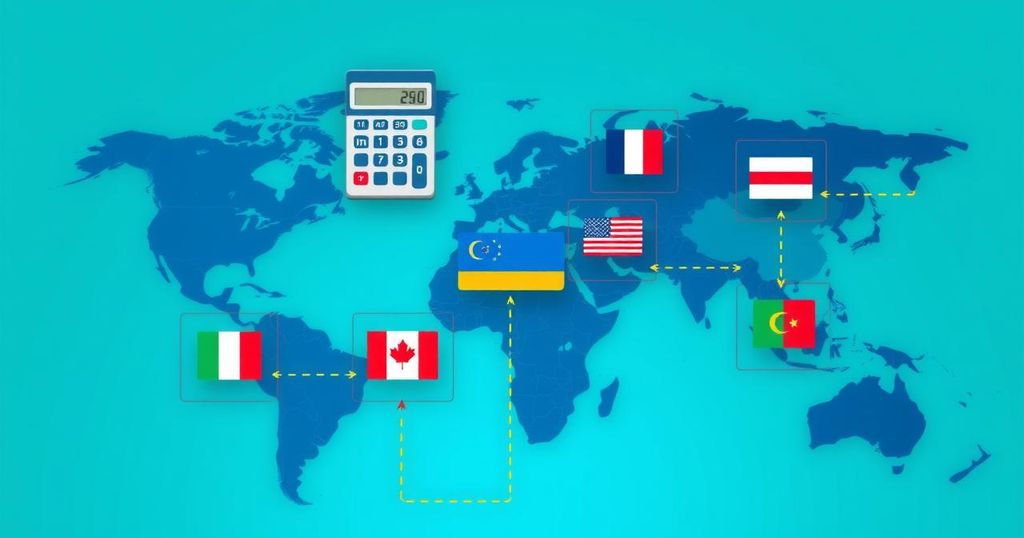Impending Reciprocal Tariffs Under Trump: Impact on Global Trade and India

President Trump is set to implement reciprocal tariffs on imports starting April 2, aiming to protect U.S. industries and generate revenue. Economists raise concerns about potential adverse effects on prices and global relations. Discussions with India and other nations continue amid uncertainties surrounding the new tariffs, while Canada and Mexico respond with counter measures. The European Union also prepares retaliatory tariffs on U.S. goods.
Since resuming office in January, President Donald Trump has adopted a stringent approach to tariff policies. He has described April 2 as ‘Liberation Day’, a date earmarked for the introduction of reciprocal tariffs on imports from various countries, signaling a push towards reducing American dependency on foreign goods. Trump’s plans suggest that these tariffs will align with the duty rates imposed by other nations on US products.
White House press secretary Karoline Leavitt has indicated that details regarding the implementation of these tariffs may be revealed by the President himself. Trump’s upcoming tariffs are aimed at protecting American industries from perceived unfair competition, generating revenue for the federal government, and exerting pressure on other nations for trade concessions.
Nonetheless, economists caution that broad tariffs could lead to negative repercussions, such as increased consumer prices and losses for global businesses due to higher costs. The uncertainty sparked by import taxes may also adversely affect financial markets and consumer confidence.
While specifics about Trump’s tariff plan remain vague, it is speculated that reciprocal tariffs may adopt forms such as by-product duties or averages applicable to all goods from designated nations. Economic advisors suggest that these tariffs could potentially generate $600 billion in revenue, averaging an impact of 20 percent.
In prior statements, President Trump has hinted at targeting several nations, including India, through reciprocal tariffs. Recently, trade discussions between India and the US have progressed, although no indications of tariff exemptions have been disclosed. Notably, delayed import taxes on Canadian and Mexican goods are poised to take effect soon as well.
On top of the upcoming tariffs, Trump has announced specific measures including a 25 percent tariff on imports from any country purchasing oil or gas from Venezuela, effective immediately. A similar tariff will apply to auto imports starting Thursday, anticipated to expand to relevant auto parts in the near future. The administration aims to acquire $100 billion in revenue from these additional duties.
Previously enacted tariffs under the Trump administration include a 10 percent tariff on all Chinese imports, which spurred retaliatory actions from Beijing. The expanded tariffs on steel and aluminum products, launched in March, also seek to eliminate existing exemptions and increase duties on aluminum.
In response to the ongoing tariff strategies, Canada has initiated counter measures, while Mexico appears to be taking a more cautious stance in the face of trade tensions. Further tariffs on various goods, including lumber and pharmaceuticals, may still be on the table as Trump remains firm in his approach.
More tariffs are likely as President Trump foresees no immediate negotiations with other nations regarding tariffs until they are implemented. The European Union has countered by preparing retaliatory tariffs on US goods valued at approximately $28 billion, targeting products such as beef, poultry, and automobiles, although these actions are currently set to commence only later in April.
In conclusion, President Donald Trump’s imminent implementation of reciprocal tariffs on April 2 is indicative of his ongoing aggressive trade stance. These tariffs aim to protect U.S. industries while generating significant revenue. However, expert opinions suggest potential adverse effects on consumer prices and international markets. Continued trade discussions, particularly with countries like India, signify a complex global trading landscape fueled by these new policies. As trade tensions escalate, it remains to be seen how both the U.S. and its trading partners will navigate this evolving situation, with potential retaliation weighing heavily on economic forecasts.
Original Source: www.hindustantimes.com







